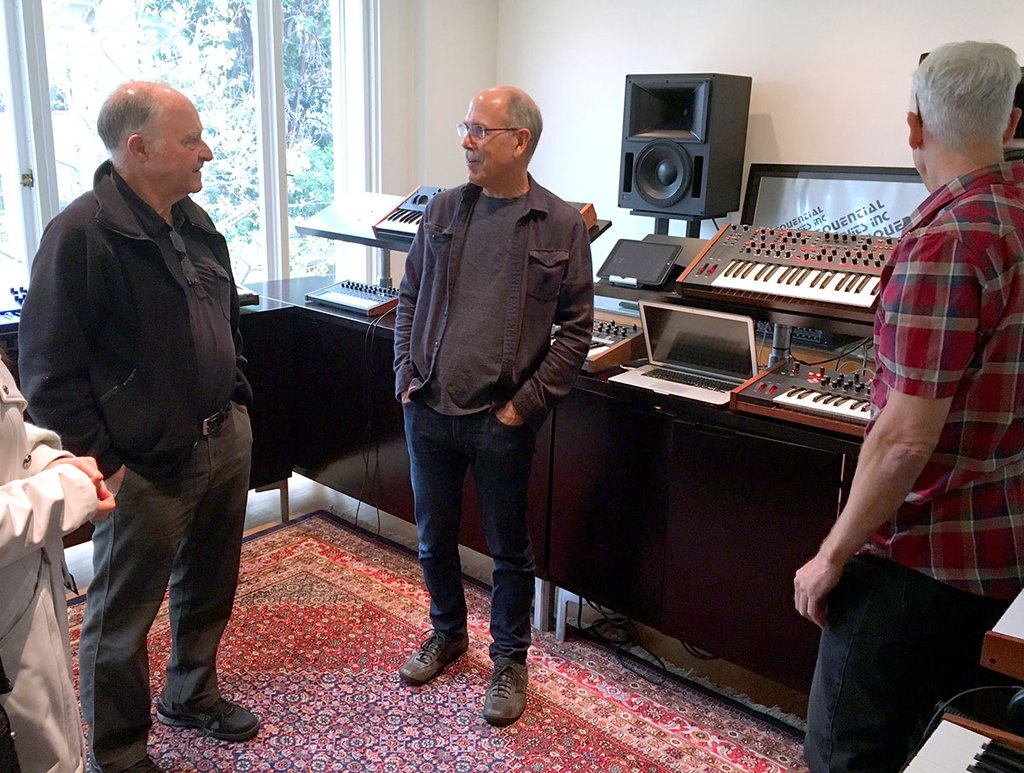 Dave Smith Instruments shared this image, capturing Dave Smith talking with John Chowning, creator of the FM synthesis algorithm. FM synthesis revolutionized keyboards in the 80s, as a result of Yamaha’s implementation in its DX line of synths.
Dave Smith Instruments shared this image, capturing Dave Smith talking with John Chowning, creator of the FM synthesis algorithm. FM synthesis revolutionized keyboards in the 80s, as a result of Yamaha’s implementation in its DX line of synths.
DSI also shared that an OS update is in the works for the Prophet 12 that will add linear FM. Details are to come.

Sorry to miss the point but what are those speakers? (loudspeakers, not the people speaking wiseguys)
This could be a shot in the dark but they look kind of similar to some of the Meyer speakers
Good guess! They are Meyers!
Exciting TimeS!
DREAM BOARD!
just when I thought my p12 could get any better! thanks dave!
This is getting serious. Anderson Cooper is interviewing Dave Smith!!!! Synths + Mainstream Media Finally!!!!
Where did you see this!?!
But isn’t that kind of FM really Phase Modulation? That’s how they can get the concept of feedback into the mix, right?
And besides, aren’t analog oscillators too imprecise to support that kind of synthesis, which is why completely digital operators were used in the end?
p12 got digital OSC not analog. you are right its not possible to do it with vco
Wrong.
Isao Tomita was using FM synthesis for his various “classitronics” tracks backs in the early 70s. That was all analogue gear. I don’t why anybody would say analogue is not precise enough for FM!
Have a look at through zero oscillators.
And thanks to the Meyer tip/\/\/\/\
It is possible to use analog oscillators for FM, they’re just not pitch-stable enough, so digital is the preferred method these days.
P12 has digital oscillators and linear or exponential FM is not PM as far as I know. I’m more concerned if the oscillators will be running at a high enough sample rate to avoid signifigant aliasing since FM can produce lots of overtones easily.
you’re correct on both points. In the end, Yamaha used a phase modulation variant approach to FM, though both FM and PM result in similar mathematical results.
Mathematically similar, yes, but audibly similar? no! I’ve heard people say ‘if each operator is a sine, its identical’, but I believe not even that is true. As you increase the modulation amount, a sort of interference pattern emerges. Yes, sines appear to stay ‘in tune’ whether it’s PM or FM, but the interference pattern is different. By interference pattern, I mean the way the sound evolves over time as the modulation increases. Of course, if the operator waveforms are no longer sines, that’s when the major difference between FM and PM appear; FM does not keep a pitch, it eventually reaches into atonality. Which is still musically interesting, particularly with low amounts. But the benefit of PM is that you can pump the modulation amounts heavily, and its still in tune. And since you can detune each operator in addition, you really got the best of both worlds.
Pro-2 next, please!
Please correct me if I am wrong, but I thought the P12 used some type of wavetables for its oscillator sound source.
It does use wavetables, but it also produces simple waveforms as well (sine, triangle, square, etc).
And you can do FM with sines or complex waves.
Yes what about an update for the Pro 2 ?
I would LOVE for this to come to the Pro-2 as well!
how many FM operators can the Prophet 6 manage?
I’m incredibly excited for this update. Of all of the synths that I have owned over the years, I have never loved anything as much as my P12. And to be honest, the FM was quite literally the only aspect of this instrument that felt slightly underwhelming. That said, the current FM has found its way into many of my patches and I’m wondering how the OS update might effect those previous patches? I’m hoping for an FM menu akin to the unison menu for mode switching.
You can select the FM mode (linear or exponential) per patch.
now it just needs a drum mode and it’ll be insane.
Hope this will be coming around to the Pro 2!
Four operators, (each oscillator can be a carrier, a modulator, or both). And you can do FM with any waveform that you select, not just sine waves.
this a good update.
makes the p12 existence more justifiable.
naturally, combining synthesis types is where the fun will be
frequency modulation works with a formula that you can use a frequency as lets say the absolute frequency and you can accurate predict the parallel frequenciys left and right of the main one, allowing you to nail the sound of real instruments very realistic, FM produce very realistic sound close to the real instrument.